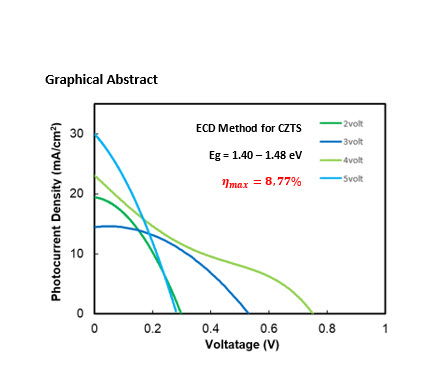Wed, Jan 29, 2025
[Archive]
Volume 20, Issue 3 (September 2023)
IJMSE 2023, 20(3): 1-8 |
Back to browse issues page
Download citation:
BibTeX | RIS | EndNote | Medlars | ProCite | Reference Manager | RefWorks
Send citation to:



BibTeX | RIS | EndNote | Medlars | ProCite | Reference Manager | RefWorks
Send citation to:
Hanifa H, Prima E C, Setiawan A, Suhendi E, Yuliarto B. Effect of Voltage on the Properties of Cu2ZnSnS4 Solar Cells by Electrochemical Deposition. IJMSE 2023; 20 (3) :1-8
URL: http://ijmse.iust.ac.ir/article-1-3016-en.html
URL: http://ijmse.iust.ac.ir/article-1-3016-en.html
Abstract: (7320 Views)
In the third generation of solar cells, cheaper absorbent layers such as Cu2ZnSnS4 (CZTS) have been developed with specifications similar to Cu2InGaS4 (CIGS). This CZTS material is known as a material with good structural and optical properties where the CZTS material has a series of atoms bonded to each other to form a kesterite or stannite crystal arrangement. In its use as an absorbent layer for solar cells, CZTS material is synthesized using the electrochemical deposition method. In this electrochemical deposition technique, an electrical circuit will be connected to the electrode and inserted into the electrolyte. Several voltage variations from 1 volt to 5 volts will be applied to the electrical circuit, which will then trigger ions from the precipitating material in the electrolyte to stick to one of the electrodes. Variation of deposition voltage was carried out to determine the effect of deposition stress on the electrochemical deposition method on the characteristics of the CZTS absorbent layer. The characterizations used are X-Ray Diffraction (XRD), UV-Vis Spectrometry, and I-V meter. XRD results show that the resulting crystal size is getting smaller with greater deposition voltage around 6.07 - 7.27 nm. The optical absorption results show that the CZTS absorber layer is sensitive at low wavelengths around 300 – 480 m,, with Light Harvesting Efficiency (LHE) ranging from 13.3 - 24.75%. The band gap energy values obtained ranged from 1.4 to 1.48 eV. The cell efficiency test results show an excellent efficiency value according to the reference ranges from 2.56-8.77%. These results indicate that the deposition voltage affects the characteristics of the CZTS absorbent layer for solar cell applications.
Type of Study: Research Paper |
Subject:
Casting and Solidification
Send email to the article author
| Rights and permissions | |
 |
This work is licensed under a Creative Commons Attribution-NonCommercial 4.0 International License. |








